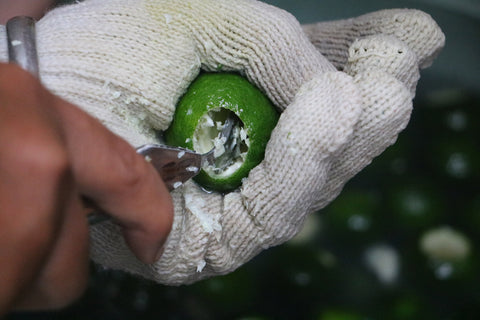For our teaCLUB's September edition, we are sampling 3 fascinating variations of Hong Kong's classic ripe Puerh tea.
Ripe Puerh is commonly served at Dim Sum restaurants in Hong Kong, so its earthy flavour is familiar to many people. However, most ripe Puerh served in restaurants is generally of a low grade. If you like ripe Puerh tea, you'll definitely want to try these 3 higher grade versions of it!

- Palace Puerh: The highest grade of ripe Puerh, which consists purely of small, delicate buds (rather than large leaves and stems). This gives it a silky smooth, almost velvety texture.
- Tangerine Puerh: Green tangerines are skillfully hollowed out then filled with high grade, 5-year-aged ripe Puerh tea. The combination of the citrus peel adds a layer of brightness to the earthy flavour of the tea.
- Rice Scent Aged Puerh: This is actually tea fossils that are steamed with the leaves of the "sweet rice leaf" plant to give them a distinctive rice aroma. A truly fascinating twist on standard ripe Puerh!
Here's a bit more about each tea and how they are made:
1. Palace Puerh 宮廷普洱
Origin: Menghai, Yunnan, China
Tasting notes: Earthy, woodsy, velvety
Once a tribute tea for emperors, this ripe Puerh is made purely of young buds, which gives it a silky smooth, velvety texture.

Ripe Puerh is fermented in a process called wet-piling (渥堆), where the tea leaves are left in humid conditions for microbes to do their work. Because the tannins are broken down during fermentation, ripe Puerh has no bitterness or astringency. It’s a delightfully mellow and relaxing tea that can be drunk in the evenings. You can also keep it for many years, as it ages well.

While the majority of ripe Puerh on the market is made from leftover, lower quality raw Puerh, we source this tea from a family who've been making ripe Puerh for three generations, and have honed the processing method for making high grade ripe Puerh in its own right, rather than as a by-product.
2. Tangerine Puerh 小青柑
Origin: Menghai, Yunnan, China & Xinhui, Guangdong, China
Tasting notes: Earthy, citrus, velvety
Green tangerines are dried and skillfully hollowed out, then filled with 5-year-aged ripe Puerh tea to make this soothing, nourishing brew. The citrus peel adds a brightness to the earthy flavour of the tea, with two seemingly opposite flavours melding into one.

Xinhui is famous for its dried tangerine peel, which is an essential ingredient in many households. It is often used as a tonic for coughs, sore throats and colds, so Tangerine Puerh a great tea for when you’re feeling under the weather.


It takes great skill to create this tea. Not only do the tangerines have to be carefully hollowed out so they remain "whole", they have to be closely monitored when drying with the tea - too fast and the flavours will not infuse properly. Too slow and they could get moldy.

3. Rice Scent Aged Puerh 糯香茶化石
Origin: Menghai, Yunnan, China
Tasting notes: Earthy, congee, pandan
Aged tea fossils are steamed with a 'sweet rice leaf’ (糯米葉) plant to produce this comforting tea that warms the body and aids digestion.

This tea is actually a type of ‘tea fossil’ (老茶頭) - its pellets don’t unfurl when brewed, so the flavour is a bit lighter and more mellow than the other two Puerhs.
During the wet-piling (渥堆) process, where the tea leaves are being fermented with microbes, they are repeatedly stirred, which sometimes causes the leaves to stick together in clumps or "fossils". The best pieces are selected then pressed into balls, cut into pellet shapes and polished.


Our Rice Sent Aged Puerh is made from 100-year old tea trees in the Menghai region of Yunnan. The ‘Sweet Rice Leaf’ (糯米葉) plant grows in the tropical rainforests of Mengla in Xishuangbanna. When the leaves of this plant are crushed, a glutinous rice scent is released. The tea is steamed with the leaves of this plant to achieve its wonderful rice flavour.
If you'd like to try all three teas, join our teaCLUB before the end of August to receive September's edition!
Join our teaCLUB and get new tea tasting experiences delivered to your door every month



Leave a comment